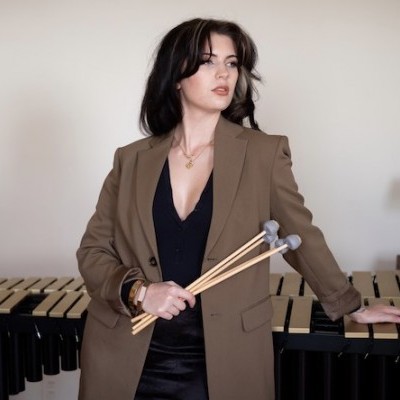Jun 3, 2025 11:25 AM
In Memoriam: Al Foster, 1943–2025
Al Foster, a drummer regarded for his fluency across the bebop, post-bop and funk/fusion lineages of jazz, died May 28…

“It’s been my goal to write and record new types of opportunities for improvisation,” Jamie Baum says.
(Photo: Courtesy Jamie Baum)The Jamie Baum Septet breezed into Dizzy’s Club in New York this February premiering a variety of pandemic-inspired music.
Inspired by journalist Bill Moyers’ online series “A Poet A Day, Poetry for the Pandemic,” Baum premiered new music replete with crisscrossing odd meters, unusual ensemble phrases, challenging structures and homophonic melodic scenarios in dense arrangements that produced wonderful solos. Baum’s music was far from the typical head/solo/head/bridge/head reprise formula of much contemporary jazz, but rather, fresh music for flute and ensemble that opened new paths of improvisation and soling possibilities for her tightly knit, extremely well-tuned, sympathetic septet with Baum on flutes, Jonathan Finlayson on trumpet, Sam Sadigursky on alto saxophone and bass clarinet, Chris Komer on French horn, Brad Shepik on guitar and singing bowls, Luis Perdomo on piano, Ricky Rodriguez on acoustic/electric basses and singing bowls, Jeff Hirshfield on drums and guest vocalist Aubrey Johnson.
“I wanted to choose poems that would express, in a programmatic way, some of the things that we’re grappling with during COVID, what it’s like to be in the midst of things, how it’s affecting us and how we might learn from it and grow or emerge from it,” Baum said during a phone call a few days after the Dizzy’s performance.
Describing it as “programmatic music,” Baum’s new work exhibited a natural rise and fall, from intense ensemble passages to freer blowing sections.The high points came in the funky picking of Shepik, the streamlined, even creamy solos of Finlayson, the exhilarating perambulations of Perdomo, Baum’s subtle but intense playing on soprano and alto flutes (with use of octave and reverb pedals), and Hirshfield (Baum’s husband) providing the swinging glue that held it all together.
This diverse lineup, performing Baum’s highly evolved material, inspired potent, powerful solos. From Shepik’s avant leanings and Perdomo’s Afro-Cuban mastery to Rodriguez and Hirshfield’s flowing, driving accompaniment based in years of work on the New York jazz scene, the musicians consistently met the demands of Baum’s compositions.
“I like to put people together that have a similar concept in terms of openness and listening, but that have different styles, in a way, because I think that they can inspire each other and it makes the music more interesting to listen to,” Baum explained.
“The first tune, ‘In The Light Of Day,’ with the singing bowls, I wanted to give the impression of life going on in a big city, where things are frenetic and we’re not really taking time to smell the roses, so to speak. Just sort of going about our daily crazy life,” Baum said.
“‘To Be Of Use,’ by Marge Piercy, talks about the value of the simple life and how we’ve undervalued that. During the pandemic we valued the essential workers, the first-line workers. Workers in the grocery store or those delivering food, they became incredibly important,” Baum continued.
“In ‘An Old Story,’ by Tracy K. Smith, she wrote that as a new story for the 21st century, a moment characterized by great social and political division. The end of the tune gets brighter and happier sounding; it’s got two sections to it,” she added.
“‘Dreams,’ I wrote in honor of a cousin who passed. He fought a long battle with cancer and was very courageous. It begins with French horn and bass clarinet, then moves to the piano. The idea of finding courage and hope wherever you can. That’s part of what we’re dealing with now.
“Then two pieces by Adrienne Rich, where she notes how we’ve lost sight as a collective. The idea of people taking care of each other. ‘What Kind of Times Are These’ was inspired by a Bertolt Brecht poem. During the Nazi occupation, he wrote, ‘What kinds of times are these when it’s almost a crime to talk about trees?’ It’s about keeping silent about so many evil deeds.”
Baum writes for musicians and music lovers, compositions based in the past but not beholden to it, performed by musicians girded for exploration and challenge.
“It’s been my goal to write and record new types of opportunities for improvisation, and also to create a different platform for the way we hear the jazz flute,” Baum said. “A band using trumpet and bass clarinet and French horn gives the flute more weight, instead of having tenor sax and baritone. The musicians tell me they love the compositions; it’s well-written so that they feel challenged.” DB

Foster was truly a drummer to the stars, including Miles Davis, Sonny Rollins and Joe Henderson.
Jun 3, 2025 11:25 AM
Al Foster, a drummer regarded for his fluency across the bebop, post-bop and funk/fusion lineages of jazz, died May 28…

“Branford’s playing has steadily improved,” says younger brother Wynton Marsalis. “He’s just gotten more and more serious.”
May 20, 2025 11:58 AM
Branford Marsalis was on the road again. Coffee cup in hand, the saxophonist — sporting a gray hoodie and a look of…

“What did I want more of when I was this age?” Sasha Berliner asks when she’s in her teaching mode.
May 13, 2025 12:39 PM
Part of the jazz vibraphone conversation since her late teens, Sasha Berliner has long come across as a fully formed…

Roscoe Mitchell will receive a Lifetime Achievement award at this year’s Vision Festival.
May 27, 2025 6:21 PM
Arts for Art has announced the full lineup for the 2025 Vision Festival, which will run June 2–7 at Roulette…

Benny Benack III and his quartet took the Midwest Jazz Collective’s route for a test run this spring.
Jun 3, 2025 10:31 AM
The time and labor required to tour is, for many musicians, daunting at best and prohibitive at worst. It’s hardly…